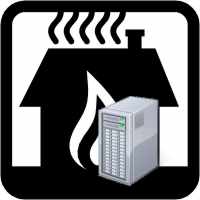| Heat your home with a server or two |
| Written by Harry Fairhead | |||
| Friday, 22 July 2011 | |||
|
Rather than build server farms that produce a lot of waster heat, why not have distributed Data Furnaces, that heat home and offices at the same time as providing cloud computing? I was reading an Asimov Sci Fi short story recently and was chuckling about the fact that he had the computer as a huge central machine in a building with huge power needs and cooling by the gallon. Of course he got that wrong how could have have possibly foreseen our tiny personal computer revolution.... and then I remembered the data centre. Huge buildings with not one machine but thousands all eating power and needing even more power to keep the whole thing cool. Perhaps Asimov was right after all! A new paper from Microsoft Research The Data Furnace: Heating Up with Cloud Computing suggest a radical but slightly mad scheme for dealing with some of the more basic problems of the data centre. To put the problem into perspective it is worth mentioning the estimated 61 Billion kWh of electricity (3% of total consumption in the U.S) that servers consumed in 2006. The basic idea is that chunks of silicon get hot as they compute and we sometimes need heat in offices and homes so why not make use of the heat to keep us warm. Instead of using dumb resistance to convert smooth flows of electricity into turbulent heat why not get a computation to do the same job. Small silicon heating elements, called Data Furnaces or DF, would replace resistive elements and provide data processing at the same time as heat. A DF would consist of between 40 and 400 processors and provide all the heat that a family home ever requires at around 40 to 50C. You would take delivery of a DF and connect it to the house air ducts, some power and of course, the internet. It also hasn't escaped the researchers that using DFs would also create a more distributed cloud computing with the processing and storage located where it was most used. The paper presents a clear financial analysis of why the scheme is a good one. It is estimated that $400 per year is spent per server in a data centre but that falls to between $20 and $60 for a DF.
So while is sounds a bit strange, it is an economical proposition. There are problems of course - the need for a good internet connection and the difficult of servicing the machines. It is suggested that the householder might get free heat in return for allowing access to the machine for routine maintenance. It is also pointed out that even if the server fails it can usually continue to provide heat until it is replaced or rebooted. It all seems very logical but there seems to be an element of "if you want to get to there don't start from here" about it. It all seems to rise the question of why we have data centres anyway. Perhaps working from that end of the equation might provide a different solution. Until then - throw another data furnace on the fire, Igor, it's getting chilly....
If you would like to be informed about new articles on I Programmer you can either follow us on Twitter or Facebook or you can subscribe to our weekly newsletter.
|
|||
| Last Updated ( Friday, 22 July 2011 ) |

